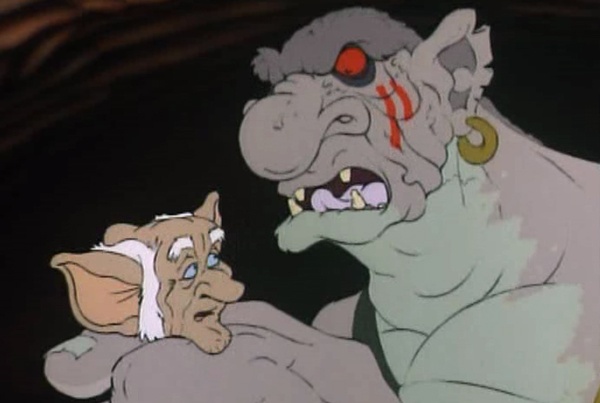How does “The BFG” compare to the previous animated adaptation?
The BFG (2016) is the latest adaptation of Roald Dahl’s classic children’s books. Over the years, we have seen Dahl’s work translated into various cinematic forms from live-action CGI to animated features. Originally published in 1982, The BFG has been adapted twice for the big screen – as an animated feature in 1989 and more recently in 2016 with Steven Spielberg at the helm to direct. Similar to The Jungle Book (2016), The BFG provides a different tone to Dahl’s story in live-action form, including the 1989 animated film. This article discusses the similarities and differences between the two adaptations and how they both provide opposing styles and tone to Dahl’s original book.
A live-action adaptation of The BFG had been in extensive development for over 20 years, perhaps triggered from the 1989 film’s success. RottenTomatoes’ critic Heather Boerner described the animated feature as “a giant tale of imagination with a dark side”, a comment suggesting that The BFG has potential to deliver in various forms. The great Steven Spielberg was at the helm of directing with John Williams composing the score. Combining Spielberg and Williams to a Roald Dahl book is evitable as the director and composer have been adventurous in family films which centre on children and explore horizons from their point of view. The BFG does this, too. Therefore, it is not only a story that involves dreams but the production behind 2016 film is a dream combination.

The BFG may be considered Dahl’s darkest story as it involves the eating of children while they’re asleep by threatening giants in another part of the world. Considering this, The BFG as a story is flexible in terms of visual and thematic tone and differentiating the book between an animated and a live-action adaptation unveils it. Both films still appear to be child-friendly and offer different interpretations of Dahl’s story (which everybody does while reading a book), but the two films oppose one another in other regards. The musical numbers in 1989 enlighten the dark tone whereas 2016 is more a high-scale fantasy adventure.
So, what exactly separates the two adaptations? Both films follow the same storyline and use the specific terminology from the book, but representations differ. The 1989 film provides a darker vision of The BFG. As it is completely animated, the filmmakers are perhaps ‘free’ to illustrate the dark tone of the book by making it scary. It does not physically star actors or feature studio settings, but the practise to create an animated set may make particularly the younger audience feel “safe” from the giants. The animators have created their own vision of England rather than making a set in physical form that is more relatable. In this regard, the live-action is closer to real-life.

Giant Country appears in a whole new dimension in 1989, particularly as the only seen passage to it seems more just going towards something in the sky. In 2016, though, Giant Country is physically inside the clouds and we see The BFG leap through them, implying the more relatable scenario of it being set in the real world.I’m not saying that it is neither more realistic nor that it is more child-friendly but as it is a children’s film set in a relatable world, it may have barriers concerning censorship, themes and visual style.
In the same regard as the 2016 film being less frightening, it’s also less violent and threatening. For example, the group of evil giants are represented as just extremely large people in live-action form. This may be to avoid the monster-like personas like how they were represented in the 1989 animation. Characteristics such as red and white eyes and extensive nails (weapons) on the index fingers of the animated Fleshlumpeater brands him as disfigured and less human. The animated Bloodbottler also dribbles uncontrollably and has a uniquely strong sense of smell, both of which may indicate a more animalistic portrayal of the giants.

The 2016 Fleshlumpeater and Bloodbottler both appear like human beings only much larger. The only dysfunctionalities are large ears (like BFG) and rotten teeth. The BFG, on the other hand, has unusually large ears as part of his job as a dreamcatcher and is skinny due to only eating a repulsive vegetable. In 2016, these characters are portrayed by actors from both make-up and motion-capture technology; further making them more humane than those in the 1989 film.
Although there aren’t any scenes of giants physically eating children in neither film (except Sophie’s nightmare), there are moments in the 2016 feature that particularly halt it. For example, when the Fleshlumpeater breaks into BFG’s house, he doesn’t eat the snozzcumber with Sophie inside it. Yet, the 1989 film and the original book tell it. It may have been either too difficult to film or it would break the barrier of the PG certificate. It may also explain why a backstory of BFG’s previous child in 2016 was acknowledged, serving as a subplot but demonstrating the giants’ threats without actually showing any real danger like the animation.

Would author Roald Dahl have liked the 2016 film? Maybe. Maybe not. According to a Den of Geek article, Dahl applauded the 1989 animation. Dahl has criticised adaptations based on his work, which also included a strong dislike for Willy Wonka and the Chocolate Factory (1971). Sadly, he passed away in 1990 and after a live-action BFG adaptation (and a 2005 remake of Charlie and the Chocolate Factory), we can only question as to how its original author would’ve compared them in terms of tone and visual style. The contemporary audience can only see it for themselves and, like The Jungle Book, contemporary Hollywood can utilise a single source and distinguish it between live-action and animation.

